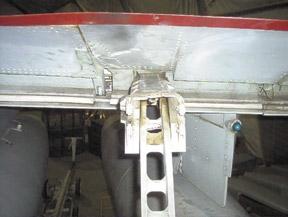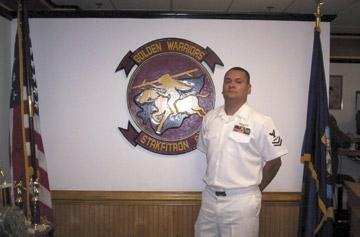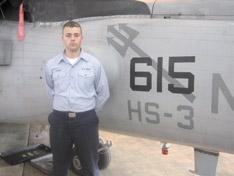
8 minute read
Failure to Communicate
from MECH Fall 2006
By AM2 Chad Hodges
Aircraft 530 returned from flight with a repeat gripe that my air frames shop could not trace. The four previous attempts to solve the “flaps slow to indicate” gripe had proven unsuccessful. Clearly, we were missing something, and we needed to get this one fixed.
Advertisement
We had replaced nearly every flapsystem component with either new parts from supply or with “known good” parts from other aircraft. Now on our fifth troubleshooting attempt, we discovered the starboard flap was very snug in the 30 degree or fully extended position. Normally, an inch-to-an-inch-and-a-half play exists in this position.
We decided to remove the starboard flap and try one last thing: “zero out” the flap gearbox. According to our publications, we would have to “place a suitable wedge under the flaperon” to hold it in the “up” position, so we could gain access to the bolt and safety wire that secure the flaperon to the airframe. With the flaperon removed, we then could remove the flap louvers, disconnect the torque tubes, and finally gain access to the flap gearbox. To put everything back together, we would roll the flap carriage assembly up by hand until we had our proper clearance, reconnect the torque tubes to the gearbox, and finally, reinstall the flaps.
It was at this point that the process went sour. Having successfully removed the louvers, flaps, and torque tubes, I thought it finally was time to zero out the gearbox. I was thinking safety first, so I doublechecked to see that everyone was clear of the flightcontrol surfaces. It was clear; however, I failed to do two things: Tell everyone involved that I was about to bring on hydraulic pressure and follow procedures that required having someone in the cockpit to make sure the controls were where we needed them. I really could add one other thing to that list: During my walk-around, I missed the wheel chock wedged under the starboard flaperon.
As I turned on hydraulic power to aircraft 530, the control surfaces slowly began moving toward the neutral This fl aperon damage was avoidable. Crew resource management is necessary in the maintenance department, too!

position—as they’re designed to do. I gradually applied more and more pressure to the hydraulic system. Suddenly, we heard a loud bang! My hand flew to the dual shut-off switches, immediately securing the hydraulic generator.
The ensuing inspection revealed that the forgotten or overlooked chock had crushed the flaperon. Sickened by the accident, we inspected the damage closely, expecting to find a lot more than occurred. The flaperon was the only part damaged. The most important factor is the safety of Sailors working the job, and no one had been injured.
Even though I checked and double-checked for anyone around the flight-control surfaces, my failure to communicate and follow procedures was the key factor in the whole mishap. I should have made it crystal clear to everyone that hydraulic power was being turned on. Everyone would have known not to approach the flightcontrol surfaces. The wheel chock would have been noticed and removed, saving time and money.
I learned a lot and lived through an embarrassing moment. With every job, no matter how small or simple, the keys to success are communication, proper planning, and doing by-the-book maintenance!
Petty Officer Hodges works in the airframe shop at VAQ-133.
Send BZs to: SAFE-Mech@navy.mil



AM1(AW) Robert Tiedemann VAQ-130
While on a routine walk-through of squadron spaces, Petty Officer Tiedemann discovered a large pipe wrench teetering on the edge of an overhead catwalk near the hangar ceiling. He carefully retrieved the wrench, preventing it from damaging the aircraft parked directly below or causing injury or death of fellow Sailors.
The wrench was not a squadron tool, and no one external to the squadron ever claimed it. Petty Officer Tiedemann’s keen observations and quick action prevented a serious event from happening.
During a routine maintenance download of pod hardbacks on Warcat 501, Petty Officer Chambers noticed a chafed wire bundle in the port engine bay. A closer look revealed these wires were part of a new weapon system.
The wiring was repaired, and the aircraft returned to flight. Had this discrepancy gone undiscovered, it would have caused significant mission degradation and could have caused an electrical fire.
AD2 Gabriel Ocampo VAW-113
Petty Officer Ocampo and other members of the power-plants work center were preparing to change the
AT3 Jeffrey Chambers VAQ-139
port engine on Black Eagle 600. Before pulling the engine, Ocampo inspected the engine trailer and found two loose bolts on the support brace, which is located on the port aft side. He immediately notified his CDI, and the engine trailer was returned for further inspection.
As a result of Petty Officer Ocampo’s action, 16 incorrect bolts were found on the engine trailer, and it was taken out of service until further maintenance could be completed. The trailer could have collapsed under an engine’s weight.

AM3 Teddy Toney


HSL-42
Petty Officer Toney found a 7-inch crack in the No. 2 engine-bay door during a daily inspection of an SH-60B. The crack was located on the bottom edge of the door, was not visible from the deck, and was impossible to see once the door had been opened. Since the door is constructed of composite material, Petty Officer Toney suspected the crack might be under the surface of the paint. He continued to look and found the crack extended into the hinge-plate area. He then immediately notified his LPO.
Had this crack progressed in flight, it could have resulted in the door departing the aircraft, causing catastrophic damage.
AD3 John Robinett VR-61 AM3 Johnrae Deguzman HSC-28
Petty Officer Robinett completed a routine daily and turnaround inspection on a C-9B. Although no discrepancies were noted, he continued to look around the inspection area, using the 18-inch rule. He suddenly noticed the fuel-shroud drain lines looked chafed. Robinett notified his supervisor, maintenance control, and quality assurance.
A QA inspection of four aircraft found two had holes in the drain lines, and two were chafed severely. Petty Officer Robinett’s find prevented a possible explosive hazard in all C-9Bs and DC-9s.
While inspecting Bay Raider 43, Petty Officer Deguzman found flaking in the swashplate guide on the main rotor head and downed the aircraft until repairs could be completed.
Subsequent inspections revealed that the swashplate guide was defective and required immediate replacement. As a result of Petty Officer Deguzman’s discovery, a critical flight component was replaced before possible structural failure.
AD3 Danny Figueroa VAQ-133
At Bagram Air Field, Afghanistan, Petty Officer Figueroa was completing an engine change on aircraft 530. He prepared for an engine installation, took out a bushing and castellated nut from a MAF bag, and began to install the aft-engine hoist swivel. Just then, as Petty Officer Figueroa began to attach the nut, he noticed it was cracked. The nut easily would have stripped off, allowing the engine to separate from the mount.
Petty Officer Figueroa then removed the nut and presented his findings to maintenance. His actions saved time, prevented a possible mishap, and revealed that a $1.6-million-dollar engine is indeed held in place by a 49-cent castellated nut.
AM2(AW) Raunel Vences


VFA-87
While doing a serial-number verification on War Party 404 for transfer to NADEP Jacksonville, Petty Officer Vences noticed a hairline crack in the planing-arm assembly on the starboard main-landing gear. Although the transfer inspection does not require inspecting this mechanism, Vences took the extra effort and found what would have led to the failure of the starboard gear upon landing.
AOAN William Turner HS-3

AD2 Brett Hopkins VAQ-139
Airman Turner noticed what appeared to be grease in the area around the quick-disconnect for the viscous-dampener bearing assembly in the tail rotor. He investigated further, found the bearing had failed during the previous flight, and verified it was damaged severely.
Airman Turner’s keen attention to detail led to the discovery of this critical safety-of-flight problem, which easily could have been overlooked.
AD3(AW) Rafael Griffin VP-16
On a routine daily inspection of a squadron P-3C, Petty Officer Griffin noticed the No. 4 ignition relay was hanging by the cannon plug. After notifying maintenance control of the discrepancy, he inspected further, finding the casing had separated from the mounting pad.
Petty Officer Griffin’s attention to detail prevented the catastrophic failure of the engine and further damage to the aircraft.
Before a late night turn on aircraft 500, Petty Officer Hopkins saw several new, microscopic impact marks on the first-stage compressor blades of the starboard engine. After notifying maintenance control, the engine was borescoped, and no other damage was found.
Had this damage not been discovered and blended, compressorblade cracks would have formed at the original impact points, leading to blade separation and catastrophic inflight engine failure.
AEAN Shamene Jones VAW-121
Airman Jones was standing prop guard on COD 46, which was parked near the fantail and about two feet from aircraft 600. When the plane captain passed control of the plane, the yellowshirt gave the signal to pull chocks and chains. Airman Jones noticed two blueshirts running toward the turning props to grab the chocks. He quickly stopped them and directed them around the props and away from harm’s way. His quick thinking and alertness prevented certain disaster and saved two shipmates.
AE2 Amy Gunter

VFC-12
While chaining down Ambush 03 for a maintenance turn, Petty Officer Gunter saw that the head of the forward attachment bolt that connects the landing-gear crank assembly to the planing link had sheared. She notified maintenance control and downed the aircraft.
Had the sheared bolt gone undetected, a planning-link failure could have occurred at any time, causing a major mishap










